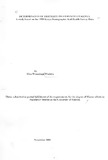| dc.description.abstract | The subject of fertility preferences is of fundamental importance for population policy and also for
family planning programs. Actual fertility primarily reflects desired fertility because it is assumed
that couples are roughly able to achieve their fertility targets. Despite this, only minimal attention
from researchers has been dedicated to the study of fertility preference. Even then, several important
factors determining fertility preferences have been left out. This study seeks to bridge the gap of
knowledge on determinants of fertility preferences.
The main objective of the study is to examine the effect of some selected study factors on
fertility preferences while controlling for the effect of other factors also known to have an effect on
fertility preferences. The study variables considered in this study include marriage type, number of
unions, child loss experience, exposure to mass media, gender mix of living children and knowledge
of modern family planning methods. Control factors that are included in the study are age, education
level, religion, region of residence, work status of the woman, place of residence and ethnicity.
Desire for more children and preferred waiting time were used in the study to designate the
dependent variable.
The study population consisted of 4887 Kenyan women of childbearing ages (15-49) covered
in the Kenya Demographic and Health Survey of 1998r The techniques of Data presentation and
analysis that were employed included use of frequency tables, cross tabulation and logistic
regression analysis. Descriptive statistics indicated that majority of the women did not desire any
more children. Cross tabulation results indicated that desire for more children is significantly
associated with all the factors included in the study with the exception of number of unions. Logistic
regression was used to regress desire for more children on the socio- demographic, socio-economic,
and socio-cultural and exposure factors. -..,The results of logistic regression show that controlling for
education, age, work status of the respondent, religious affiliation, ethnic background, place and
VB
region of residence, only two of the study variables were found to be significant in explaining
differences in fertility preferences. These were the number of unions, and gender mix of living
children. Before controlling for these factors, all other factors apart from number of unions were
found to be significant in explaining differences in fertility preferences of Kenyan women. These
included the type of marriage, knowledge of modem family planning methods, gender mix of living
children, child loss experience and exposure to mass media.
The study also found that those factors that are responsible for differences in the desire for
more children are also important determinants of preferred waiting time to the next birth .The study
found that gender mix of living children and number of unions are important determinants of
preferred waiting time. In addition the type of marriage was also found to be important. These
factors were found to be important determinants of desire for more children revealing a consistency
between the two measures of fertility preferences.
The major conclusion that was derived from the results of this study was that all the study
variables included in the study are important determinants of fertility preference. However the study
found that gender mix of living children an.d.•. the number of unions are the most important factors
determining fertility preference controlling for all other factors included as controls in the study.
Other factors found to be important determinants of fertility preference included age and ethnicity.
On the basis of these results and conclusions, recommendations have been made for policy
as well as for research. The findings indicated that gender preference is evident in Kenya either in
favour of an equal mix ofliving children or better still in favour of sons. This kind of preference has
contributed to high fertility preferences especially among women with more daughters. This scenario
demands that more efforts be made to address the existing gender disparities so as to fully integrate
gender concerns into the development process. This kind of a shift can occur within a milieu of
Vlll
broad social, economic and cultural change involving changes in the role of women education,
economic structure, family structure and more particularly changes in social and cultiral beliefs and
traits that favor men hence disadvantaging women leading to a low preference for girls among
parents. The study also found that marital instability is a major contributory factor to higher fertility
preferences. Policy measures should be geared towards promotion of marital stability and support to
the family as the basic unit of the society. | en |

